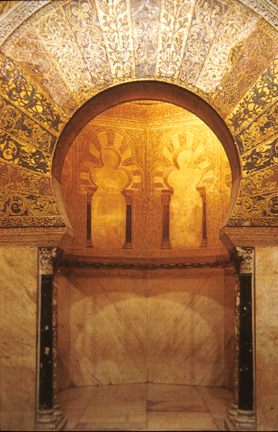Spain was part of the Muslim world for over 700 years (711-1492 CE) as the forces of Islam conquered the southern part of the Iberian peninsula. Al-Andalus was the name the Moors called their empire in Spain, and even to this day, the southern part of Spain is called Andalusia. The art of this period has come to be known as Hispano-Moresque, reflecting this fusion of Islamic and Spanish styles. Cities such as Córdoba, Ronda, Malagá, Granada, and Seville were part of al-Andalus, with Córdoba being the earliest seat of power. The great mosque in Córdoba, the Mezquita, was built between 785 and 787 by Abd al Rahman I and was the embodiment of Islam in Iberia for centuries. Within the Mezquita is a veritable 'forest' of over 850 granite, jasper, and marble columns, topped with horseshoe arches that support the structure. Many of these columns were stolen from previous Roman and Visigoth buildings to construct the Mezquita, forming a architectural history of the various rulers of Córdoba over the millennia. The jewel of the Mezquita is this gilded mihrab. The entrance to this richly adorned prayer niche is a horseshoe arch, called a Caliphate arch supported by two of these marble columns. This mihrab, one of the most beautiful in all of Islamic architecture, was built in 950CE by Hakam II. It is elaborately ornamented in stucco, gold leaf, and tile, and originally held a gilt copy of the Koran. The worn flagstones of the floor indicate where centuries of faithful pilgrims would circle the Koran 7 times on their knees.
During Europe's 'Dark Ages' that followed the sack of the Roman Empire, it was the Islamic world that kept alive the knowledge of mathematics, literature, and science of the classical Greek and Roman world. It was through the academies of cities like Córdoba this treasure was passed back to the Europeans. Philosophers such as Maimónides and many others taught and studied in Córdoba. Maimónides was a Jew and during this period in al-Andalus, religious communities of Jews and Muslims lived in harmony.
With the fall of Córdoba to Catholic forces, the seat of Islamic power in Iberia would shift to Granada and the Nazarid rulers. During the 1500's CE, a Catholic church was built within the walls of the Mezquita, and provides an odd juxtapositon today as its Roman Catholic architecture sits amidst the splendor of the Mezquita with its 850 Caliphate arches and prayer niches.

Mihrab in the Mezquita, Córdoba, Spain 950 CE


